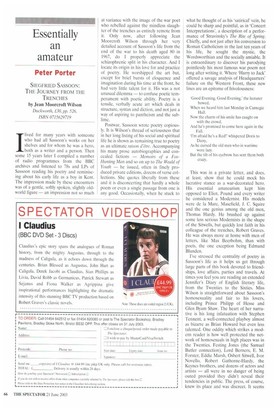Essentially an amateur
Peter Porter
SIEGFRIED SASSOON: THE JOURNEY FROM THE TRENCHES by Jean Moorcroft Wilson Duckworth, £30, pp. 526, ISBN 0715629719 Ilived for many years with someone who had all Sassoon's works on her shelves and for whom he was a hero, both as a writer and a person. Then some 15 years later I compiled a number of radio programmes from the BBC archives and listened to 78s and LPs of Sassoon reading his poetry and reminiscing about his early life as a boy in Kent. The impression made by these encounters was of a gentle, softly spoken, slightly oldworld figure — an impression not so much at variance with the image of the war poet who rebelled against the mindless slaughter of the trenches as entirely remote from it. Only now, after following Jean Moorcroft Wilson through her very detailed account of Sassoon's life from the end of the war to his death aged 80 in 1967, do I properly appreciate the schizophrenic split in his character. And I locate its origin in his love for and practice of poetry. He worshipped the art but, except for brief bursts of eloquence and imagination during his time at the front, he had very little talent for it. His was a not unusual dilemma — to confuse poetic temperament with poetic ability. Poetry is a tensile, verbally acute art which deals in structure, syntax and diction, and not just a way of aspiring to pantheism and the sublime.
Postwar, Sassoon wrote poetry copiously. It is Wilson's thread of seriousness that in her long listing of his social and spiritual life he is shown as remaining true to poetry as an ultimate raison d'être. Accompanying his many prose autobiographies and concealed fictions — Memoirs of a FoxHunting Man and so on up to The Weak! of Youth — he issued, often in finely produced private editions, dozens of verse collections. She quotes liberally from these and it is disconcerting that hardly a whole poem or even a single passage from one is any good. Occasionally, when he stuck to what he thought of as his 'satirical' vein, he could be sharp and pointful, as in 'Concert Interpretations', a description of a performance of Stravinsky's The Rite of Spring. Chiefly, and not just after his conversion to Roman Catholicism in the last ten years of his life, he sought the mystic, the Wordsworthian and the socially amiable. It is extraordinary to discover his parodying pointlessly his most famous war poem not long after writing it. Where 'Harry to Jack' offered a savage analysis of Headquarters' failure on the Western Front, these new lines are an epitome of frivolousness:
'Good Evening, Good Evening,' the lecturer bowed, When we heard him last Monday in Carnegie Hall.
Now the charm of his smile has caught on with the crowd, And he's promised to come here again in the Fall.
'I'm afraid he's a Red!' whispered Doris to Daisy, As he cursed the old men who in wartime were lazy.
But the tilt of his eyebrow has sent them both crazy.
This was in a private letter, and does, at least, show that he could mock his lucrative stance as a war-decorated hero. His essential amateurism kept him opposed to Eliot, Pound and every writer he considered a Modernist. His models were de la Mare, Masefield, J. C. Squire and the one genius among the old men, Thomas Hardy. He brushed up against some less serious Modernists in the shape of the Sitwells, but quickly lost faith in his colleague of the trenches, Robert Graves. He was always more at home with men of letters, like Max Beerbohm, than with poets, the one exception being Edmund Blunden.
I've stressed the centrality of poetry in Sassoon's life as it helps us get through large parts of this book devoted to friendships, love affairs, parties and travels. At times you feel you are reading an extended Jennifer's Diary of English literary life, from the Twenties to the Sixties. Miss Wilson is straightforward about Sassoon's homosexuality and fair to his lovers, including Prince Philipp of Hesse and Glen Byam Shaw. The heart of her narrative is his long infatuation with Stephen Tennent, a well-connected playboy almost as bizarre as Brian Howard but even less talented. One oddity which strikes a modern reader is how well protected the network of homosexuals in high places was in the Twenties. Festing Jones (the Samuel Butler connection), Lord Berners, E. M. Forster, Eddie Marsh, Osbert Sitwell, Ivor Novello, Robert Gathorne-Hardy, the Keynes brothers, and dozens of actors and artists — all were in no danger of being outed provided they didn't reveal their tendencies in public. The press, of course, knew its place and was discreet. It seems that Auden's and Isherwood's generation, while appearing to be bravely fighting for tolerance, was in fact enjoying the spice of danger which revelation could provoke.
Sassoon's marriage was not happy, though it gave him a loved son, George. He came to loathe the presence of his wife at home or when visiting friends. Only in his last years did Catholicism make him more tolerant of her It's a pity this book does not convey the great charm of his personality, something well attested to by friends and memorialists. As with so many biographies, the subject's character continues to elude the reader. Nevertheless, I'd forgive him anything for his love of music and his willingness to sit down at a moment's notice at the keyboard to play Bach. His war poems will keep his reputation alive, and to have introduced William Walton to the Sitwells and to have received the dedication of Portsmouth Point should prove immortality enough.



































































































 Previous page
Previous page